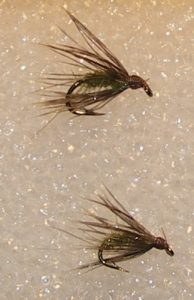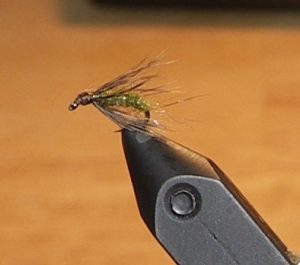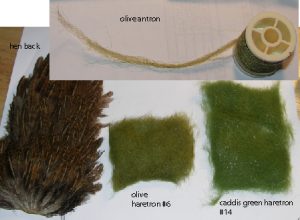Caddis soft hackle
This can imitate the pupae or diving/drowned caddis. It can be fished on the surface, in the film or deep in tandem with a weighted/bead head nymph. This is particularly deadly when the crawling olive caddis emerge in the evenings from Mid-May until the end of June. It can be tied in tan too.
Hook: Mustad 3906 size 14 and 16
Thread: uni-thread 8/0 camel
Rib: Size 16, three turns gold ultra-wire (SM); Size 14, four turns gold ultrawire brassie size (BR).
Body: Haretron olive (HE#6) or caddis green (HE#14)
Overbody (optional) :4-6 strands of olive antron, extending past the hook bend
Hackle: mottled hen back or dark partridge
Instructions
- Dub the body from the start of the bend forward with moderate tightness so that a slight pucker develops when wrapping the wire.
- The angle of the hackle is controlled by the taper of the dubbing over which the hackle is wound. Too sharp of a transition makes the hackle flair outward from the body, which I don’t think is good.
- Wrapping the softhackle. It is not tied off the way hackle on a catskill dry is tied. The hackle/feather is wrapped forward, with the fibers stroked backwards, to just before the hook eye. The thread is wrapped back over the area where the stem was tied to form the head. This binds the hackle to the fly with the thread rather than relying on the barbs adhering to the stem. This makes the fly more durable.
- Cement the wraps.
- A significant, but not overly large, head is made from the thread. Cement wraps.
- I tend to tie the hackle heavier than most people do. This is because the soft hen back and partridge on the small sized flies lose fibers while fishing, especially when fished deep in shift runs. I trim them streamside to match conditions- I make the hackle more sparse for skinny, clear water and when fished on the surface “greased” or in the film.



